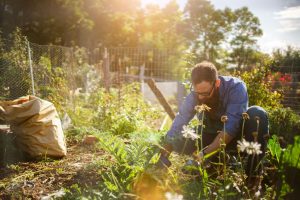With the continuous rise of food and transportation costs, it is now more practical and a lot easier to grow your own food at home. In fact, it can be a good business for you to start and offer to your community. Planting a vegetable garden isn’t as hard or as expensive as most people think. We have listed down a few simple steps to get you started.
Vegetable Gardening for Beginners
Pick the right spot.
When it comes to vegetables, location matters. Most plants need at least six hours of daylight exposure. Be sure to pick a spot in your garden where there is ample sunlight throughout the day. Not only that, but you also have to consider soil quality if you are planting directly into the ground. Plant roots grow easily on soft soil. Enriching it with compost helps provide your plants with the nutrients they need to grow properly so you can yield more harvest.
Determine the type of bed you will use.
This decision should be made in the early stages of planning. There are three basic bed options, with a combination of the three as another viable option to take.
Raised Beds. One of the simplest ways to grow a garden. Plus, this provides instant protection against weeds and grass from getting into your garden.
Pots. Pots are practical as they are flexible and can be moved anywhere in the garden. They are especially helpful if you have limited garden space.
Ground. The oldest method of planting and farming.
Decide if you will use seeds or a starter plant.
You saw a collection of seeds at the garden shop, and you buy them thinking that plants will pop up from the ground after planting them. Well, it’s not as easy as that.
If you’re new to gardening, it would be best to get a starter plant instead of propagating seeds. Your $30 could probably fetch you about 20 to 25 plants, which are ideal numbers for beginners to work with. If you’ve had some experience propagating seeds, then go ahead and try it out. Pick the easier plants to grow like carrots, radishes, lettuce, beans. Chard, and spinach. Be sure to check the package first for instructions.
Put a watering system in place.
You need to plan for a way to water your plants. Some install an automated or timed water system while others prefer watering their plants by hand. It allows them to check their plants for pests and pull some weeds out. Whether you hand-water your plants or use an automated system, you need a sustainable and efficient watering system.
Prepare for pests.
Insects, worms, birds, rodents, snakes — different kinds of pests are waiting to feast on your garden. The good news is there are plenty of organic and natural pest control products online and at local gardening shops. Whatever you choose, just keep in mind that if your soil is healthy, your plants will also be healthy and pests will not stick around. Also, you may need a 12-volt sprayer to get this task done faster. For bigger pests like rodents and birds, netting and fencing the garden will help keep them away.
Fertilize your garden.
Fertilizers help produce healthy vegetables and fruits. You can search online or locally for a slew of natural and organic fertilizers. Healthy soil yields healthy plants, which don’t need much fertilizer, but overfertilizing will bring about insect infestation.
Simply because you followed everything here doesn’t mean you will always be successful at gardening. Failures are a normal part of it. Just master these basics, pick up a few tips and tricks along the way, and you and your garden will be fine.


